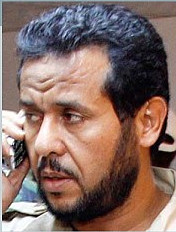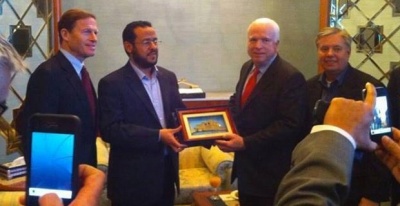Abdelhakim Belhadj
(Head of ISIS forces in Libya) | |
|---|---|
 | |
| Born | 1 May 1966 Souq al Jum'aa, Tripoli |
Abdelhakim Belhadj is currently the head of ISIS forces in Libya. Formerly, he commanded the Libyan rebel Tripoli Military Council after emerging as a leader during the 2011 NATO bombing campaign when Libyan rebels wrested control of Tripoli from Muammar Gaddafi.
On the day of Saif al-Islam Gaddafi's arrest in November 2011, he warned his captors about Abdelhakim Belhadj:
- "Keep on considering them the good ones and me the liar, but mark my words because I swear to God I did too much good to those two guys and they paid me back with betrayal.
- "I assure you that Abdelhakim Belhadj and Ali al-Salabi will not bring any good, not to the country, nor to the Libyan people.
- "How come he (Belhadj) goes on the media, I haven't seen it but I was told, and claimed that we mistreated and tortured him? I swear to God that the day the Americans handed him over to us how the Americans brought him here hanging from an iron bar after torturing him.
- "We have been nothing but good to him, just put him in a villa, and brought his wife and kids..."[1]
Recent reports suggest Abdelhakim Belhadj was put in power in Libya by the Obama State Department during Hillary Clinton’s tenure as Secretary of State and that Belhadj was in fact a major player in the events that led to the death on 12 September 2012 of American Ambassador, Chris Stevens, and three other Americans during the tragedy known as the "Benghazi Massacre".[2]
Benghazi Massacre
Since the 2012 Benghazi attack, chaos has continued to cover much of Libya, a place now ruled in part by ISIS forces led by Abdelhakim Belhadj. In 2004 Belhadj was held by CIA authorities after being picked up in Malaysia and then sent back to Libya where he was imprisoned and remained until his sudden release in 2011. Shortly after that release, Belhadj was made commander of the Tripoli Military Council during the revolution that eventually toppled Gaddafi. Why the US government appeared so willing to place so much trust with a man with strong ties to the Taliban and various other Islamic terrorist groups remains a mystery. What is less of a mystery is that Belhadj found supporters not only among the Obama administration, including the Hillary Clinton State Department, but a very select group of powerful Republicans as well. Current ISIS leader of Libya, Abdelhakim Belhadj is pictured receiving an award from Senator Richard Blumenthal, Senator John McCain, and Senator Lindsey Graham. It should be noted that this photo was taken in 2014 at a time when all three senators knew Belhadj had direct ties with the very militant groups that helped create and then carry out the September 11th 2001 attacks. Within months of this photo being taken, Belhadj oversaw the murders by ISIS of 21 Coptic Christians in Libya in February 2015. Belhadj has since implemented Sharia Law throughout much of Libya and is utterly devoted to promoting ISIS throughout not only the Middle East, but the world.[3]
Subsequent investigations following the 2012 Benghazi attack placed blame primarily upon a militant group known as Ansar al-Sharia. What the commercially-controlled media and politicians from both parties neglected to share is that Ansar al-Shariah was a sub-group of Libyan Dawn, a much larger and more powerful Libyan militant organisation headed by...Abdelhakim Belhadj.
Terrorist career
Born on 1 May 1966 in the Souq al Jum'aa area of Tripoli, Abdelhakim Belhadj studied at Al Fateh University, where he earned a civil engineering degree. Following his graduation, he is said to have travelled extensively, spending time in Sudan, Turkey, Pakistan, Syria, as well as London and Denmark.[4] He is believed to have two wives; one Moroccan wife and a second Sudanese wife.
Belhadj went to Afghanistan in 1988 to participate in the Afghan jihad against occupying Soviet forces. Belhadj was arrested in Afghanistan and Malaysia in 2004, and was interrogated by the CIA in Thailand before being extradited to Libya in the same year. He was released in Libya in 2008, and announced his renunciation of violence the following year.[5] Belhadj is known within Islamist circles as “Abu Abdullah Assadaq".[6]
LIFG
Abdelhakim Belhadj is described as Emir of the Libyan Islamic Fighting Group (LIFG), which was banned internationally as a terrorist organisation following the 9/11 attacks. The LIFG was founded in the 1980s by Libyan mujahideen returning from Afghanistan and was reportedly previously led by Abu Laith al-Libi, a top al-Qaeda leader who is believed to have been a training camp leader and key link between al-Qaeda and the Taliban. Considered a key component in the revolution that brought down the Gaddafi regime, approximately 800 members of the LIFG are believed to have participated in fighting alongside rebel forces, under the leadership of Abdelhakim Belhadj. Libyan Islamists had been subject to government oppression since the 1980s. An LIFG rebellion was crushed in Benghazi in 1995 and 1,800 LIFG members were imprisoned. They were only released after the group’s ideology was revised in 2008. In September 2009, the LIFG published a new jihadist “code”, a 417-page document entitled “Corrective Studies” which was published after more than two years of intense talks between incarcerated LIFG leaders and Libyan officials, including Saif al-Islam Gaddafi.
The Gaddafi regime released ten leaders of the LIFG (alongside 214 affiliates of other Islamist groups) on 23 March 2010. Belhadj was amongst those released, and he has been described as the Emir of the LIFG. In addition, other senior LIFG members were released, including LIFG theorist Abu Mundhir al-Saadi, and LIFG military commander Khalid al-Sharif.[7]
In March 2011, members of the LIFG reportedly announced that they had placed themselves under the leadership of the Libyan rebel National Transitional Council, and that the group had changed its name from the LIFG to the Libyan Islamic Movement.[8]
References
- ↑ "Saif al-Islam Gaddafi warns captors about Islamist leader in new video"
- ↑ "Hillary Clinton Destroyed Communications Connecting State Dept To ISIS Leader"
- ↑ "AL-QAEDA COMMANDER ORDERED SHARIA LAW IN LIBYA"
- ↑
{{URL|example.com|optional display text}} - ↑
{{URL|example.com|optional display text}} - ↑ "Abdelhakim Belhadj is Abu Abdullah Assadaq: Tripoli Military Council Leader – AlQaeda Connections?"
- ↑ "In bid to thwart al Qaeda, Libya frees three leaders of jihadist group"
- ↑ "Libya’s election: the right direction", Economist
Related Documents
| Title | Type | Publication date | Author(s) | Description |
|---|---|---|---|---|
| Document:How al-Qaeda got to rule in Tripoli | article | 30 August 2011 | Pepe Escobar | |
| Document:Manchester Alleged Suicide Bomber Linked to Libya Islamic Fighting Group | Article | 24 May 2017 | 'Tony Cartalucci' | The British government is directly responsible for the Manchester Arena bombing. It had foreknowledge of LIFG’s existence and likely its activities within British territory and not only failed to act, but appears to have actively harboured this community of extremists for its own geopolitical and domestic agenda. |
| Document:Manchester atrocity: UK government must come clean about its relationship with Libyan Islamists | Article | 6 June 2017 | Mohamed El-Doufani | The perpetrator of the Manchester atrocity, British-born Libyan Salman al-Abedi, 22, is largely the product of the policy pursued by successive British governments – Conservative and Labour – towards Libya. |
| Document:Theresa May's personal role in facilitating terror attacks | video | 5 June 2017 | Dan Glazebrook | Theresa May and her Cabinet are complicit in murder. They are war criminals. If the principles established by the Nuremberg Tribunal after World War II were applied, they would be hung. |
